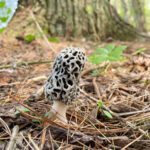Blair Garrett
A little-known hunting hobby has hit the scene, and springtime is the perfect time of year to jump right in. Don’t tell anyone!
Frederick County is home to a lot of hunters, and it’s an activity that’s usually passed down from generation to generation.
This hunting activity, however, is quite a different kind of hunting. Mushroom hunting is a tremendously growing hobby, and a great way to get your daily steps, get to know your area, and add a locally grown ingredient to your family dinners.
Mushroom hunting takes a bit of knowledge to get started, but avid hunters count down the days until it’s warm enough for their favorite breed of mushrooms to start growing.
Knowing a mushroom’s ideal environment is a must. They are incredibly adaptive fungi that can flourish in a variety of environments, but they really excel in warm, rainy climates. Your common April showers followed by periods of mid-70-degree weather are when mushrooms really pop.
Mushroom foragers all over Maryland rave about hunting the elusive “morel mushrooms.” Morels are a distinct and very tasty mushroom that have become the darling of the hunting community. With a honeycomb-like top and great flavor, hunters spread far and wide come mushroom season when morels are in bloom. Typically, they’re most commonly found in May when the ground temperature starts to rise, but with how unseasonably warm this winter was, don’t be surprised if you find a few earlier than expected.
When picking mushrooms, it’s important to clip them or twist and pull right at the bottom of the stem. Pulling them directly out of the ground can damage the mycelium in the top of the soil.
Morel hunters can be very protective of their hunting grounds, so be sure to check and see if the area you’re hunting is encroaching on someone else’s territory. Keeping an open eye on fallen trees, tree trunks and the ground floor of shaded terrain should yield all mushroom hunters great results.
There are a few extremely important things to be aware of when diving into your first mushroom hunt. There are 100 different poisonous mushroom species, and nearly two dozen of them are potentially lethal to humans. It’s important to be able to identify what type of mushroom you’re interested in hunting and any potential similar mushrooms that may leave you with a bad stomach ache or worse.
Morels, the most popular mushrooms among fanatics, even have a poisonous alter ego. False morels look similar to their widely hunted counterparts, but they have a distinctly melted appearance to them and a lack of the trademark pitted holes that traditional morels have.
There are lots of online guides and resources for new and experienced mushroom hunters that can be of great help in identifying edible and dangerous mushrooms.
With thousands of mushroom species found across the United States, you are bound to have some variability in the taste of mushrooms. But mushrooms happen to be one of the most unique things our earth has to offer. You have delicious mushrooms, poisonous mushrooms, and mushrooms with very special properties.
Psilocybin mushrooms, or more frequently known as psychedelic mushrooms, gained popularity in the west in the 1950s. They have been used recreationally across the United States for decades until recently, where there’s been a big push to legalize the use of them for medicinal purposes.
Clinical trials have had extremely positive feedback for microdosing psilocybin mushrooms to treat things like Post-Traumatic Stress Disorder (PTSD) and Depression, and have had a particularly strong impact treating veterans and cancer patients.
Though recreational use remains illegal, it has been decriminalized in select cities and has gained a lot of advocates as an alternative treatment option to standard pharmaceutical drugs in just the past few years.
While mushrooms have the potential to treat medical conditions and alter reality, perhaps the strangest type of fungus is the cordyceps fungi.
Cordyceps is a species of fungi that has been thrust to the forefront of pop culture through the popular game and HBO series “The Last of Us,” but the shocking reality of the “zombie fungus” is its real life method of transmission. In the show, a mutated strain of cordyceps allows the fungus to infect a human host, turning them into bloodthirsty zombies. In the real world, cordyceps fungi aren’t able to survive in humans due to our natural body temperature and a variety of other factors, but they are known to infect ants with spores, draining their host completely of nutrients while the spores reproduce.
What’s remarkable about these fungi is its interaction with the host once the host is infected. The spores from the fungi have a parasitic relationship where they can control the insect’s body until its eventual demise.
It’s theorized that the parasitic spores control the ant’s motor function through chemical changes or the manipulation of muscle fibers, but what is known is that the ants or infected insects will forcibly climb to higher ground, so when the spores are released after the host dies, it has easier access to spread.
As far-fetched as it sounds, there are tons of videos and documented cases of ants climbing to the tops of plants or grass while infected to spread the fungi across a greater area than it would be able to right from the ground it grows out of. That’s a terrible sci-fi film waiting to happen.
While cordyceps aren’t found locally, there are some really great and edible mushrooms that will be popping up in just a few short weeks. Whether you’re an annual mushroom hunter or a newbie looking for a great outdoor activity, the Catoctin Mountains is home to some of the best hunting grounds in Maryland, and there’s something out there to find for everyone.


